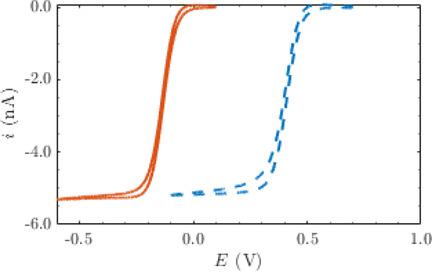当前位置:
X-MOL 学术
›
Electroanalysis
›
论文详情
Our official English website, www.x-mol.net, welcomes your
feedback! (Note: you will need to create a separate account there.)
Probing TCNQ‐mediated Metal Reduction Reactions at Liquid‐liquid Interface with SECM
Electroanalysis ( IF 2.7 ) Pub Date : 2019-12-23 , DOI: 10.1002/elan.201900571 Eemi Nieminen 1 , Nargiz Kazimova 2 , Lasse Murtomäki 1
Electroanalysis ( IF 2.7 ) Pub Date : 2019-12-23 , DOI: 10.1002/elan.201900571 Eemi Nieminen 1 , Nargiz Kazimova 2 , Lasse Murtomäki 1
Affiliation

|
Metal reduction at the interface between two immiscible electrolyte solutions (ITIES) has been studied with scanning electrochemical microscopy (SECM). Metal cations in the aqueous phase are reduced by 7,7,8,8‐tetracyanoquinodimethane anion (TCNQ−) residing in the oil phase, methyl isobutyl ketone (MIBK). TCNQ− is formed at the SECM tip by reducing TCNQ, which results in a positive feedback loop between the tip and the ITIES when an electron is donated to a metal cation. The effect of the Galvani potential difference on the rate of the interfacial electron transfer was investigated, establishing the potential difference either by an additional substrate electrode in the aqueous phase or by an a common ion in both phases. It is shown that the Galvani potential difference as a driving force does enable TCNQ− mediated Cu2+ reduction. Finite element method (FEM) simulations were run to provide information on the reaction kinetics and stoichiometry.
中文翻译:

在SECM的液-液界面处探索TCNQ介导的金属还原反应
已经用扫描电化学显微镜(SECM)研究了两种不混溶的电解质溶液(ITIES)之间的界面处的金属还原。在水相中的金属阳离子被7,7,8,8-四氰基阴离子(TCNQ减少-驻留在油相中,甲基异丁基酮(MIBK))。TCNQ -通过减少TCNQ在SECM尖端上形成SNP,当将电子捐赠给金属阳离子时,会在尖端和ITY之间产生正反馈回路。研究了Galvani电势差对界面电子转移速率的影响,通过水相中的附加基质电极或两相中的公共离子确定了电势差。结果表明,作为驱动力的伽伐尼电位差不会使TCNQ -介导的Cu 2+还原。运行有限元方法(FEM)模拟以提供有关反应动力学和化学计量的信息。
更新日期:2019-12-23
中文翻译:

在SECM的液-液界面处探索TCNQ介导的金属还原反应
已经用扫描电化学显微镜(SECM)研究了两种不混溶的电解质溶液(ITIES)之间的界面处的金属还原。在水相中的金属阳离子被7,7,8,8-四氰基阴离子(TCNQ减少-驻留在油相中,甲基异丁基酮(MIBK))。TCNQ -通过减少TCNQ在SECM尖端上形成SNP,当将电子捐赠给金属阳离子时,会在尖端和ITY之间产生正反馈回路。研究了Galvani电势差对界面电子转移速率的影响,通过水相中的附加基质电极或两相中的公共离子确定了电势差。结果表明,作为驱动力的伽伐尼电位差不会使TCNQ -介导的Cu 2+还原。运行有限元方法(FEM)模拟以提供有关反应动力学和化学计量的信息。









































 京公网安备 11010802027423号
京公网安备 11010802027423号